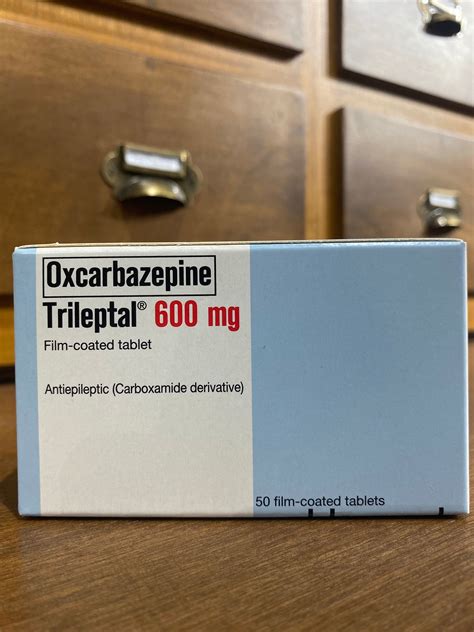Intro
Discover what Oxcarbazepine is, a medication for epilepsy and bipolar disorder, with uses, side effects, and interactions, as an anticonvulsant and mood stabilizer.
Oxcarbazepine is a crucial medication in the realm of neurology and psychiatry, playing a significant role in the management of various neurological conditions. Its importance stems from its efficacy in treating conditions such as epilepsy, bipolar disorder, and nerve pain. The drug's mechanism of action, benefits, and potential side effects make it a subject of interest for both medical professionals and patients seeking to understand their treatment options better. As we delve into the world of oxcarbazepine, it becomes clear that understanding this medication is key to appreciating its value in modern medicine.
The use of oxcarbazepine has been on the rise due to its relatively favorable side effect profile compared to some older anticonvulsants and mood stabilizers. This has led to increased research and clinical interest in its applications, including its potential off-label uses. Furthermore, the medication's pharmacological properties make it an attractive option for patients who have not responded well to other treatments. The importance of oxcarbazepine in the treatment arsenal against neurological and psychiatric conditions cannot be overstated, given its ability to improve the quality of life for countless individuals worldwide.
As we explore the realm of oxcarbazepine, it's essential to consider the broader context of neurological health and the challenges associated with managing conditions like epilepsy and bipolar disorder. The development of effective treatments like oxcarbazepine represents a significant advancement in the field, offering hope to patients and their families. By examining the drug's working mechanisms, benefits, and potential drawbacks, we can gain a deeper understanding of its role in contemporary healthcare. This knowledge not only empowers patients but also contributes to ongoing discussions among healthcare professionals about the best practices in treating neurological conditions.
Introduction to Oxcarbazepine

Oxcarbazepine is an anticonvulsant or antiepileptic drug (AED) used primarily in the treatment of partial seizures and generalized tonic-clonic seizures. It is also used in the treatment of trigeminal neuralgia and has found applications in managing bipolar disorder, particularly in patients who do not respond adequately to other treatments. The drug functions by inhibiting repetitive neuronal discharges through its blocking effect on sodium channels, which are crucial for the generation and propagation of seizure activity. This mechanism of action underlines its effectiveness in controlling seizures and its potential benefits in managing other conditions characterized by abnormal neuronal excitability.
Pharmacological Profile
The pharmacological profile of oxcarbazepine is characterized by its high bioavailability, extensive metabolism in the liver, and relatively long half-life, which allows for twice-daily dosing. Its active metabolite, licarbazepine, is primarily responsible for the drug's therapeutic effects. The metabolism and pharmacokinetics of oxcarbazepine contribute to its favorable side effect profile and make it a preferable option for many patients.Benefits of Oxcarbazepine

The benefits of oxcarbazepine are multifaceted, reflecting its versatility as a therapeutic agent. Some of the key advantages include:
- Efficacy in Seizure Control: Oxcarbazepine has been shown to be effective in controlling partial seizures and generalized tonic-clonic seizures, making it a valuable option for patients with epilepsy.
- Mood Stabilization: Its use in bipolar disorder highlights its potential in managing mood swings and preventing depressive or manic episodes.
- Pain Relief: The drug's efficacy in treating trigeminal neuralgia underscores its role in managing certain types of nerve pain.
- Favorable Side Effect Profile: Compared to some other anticonvulsants, oxcarbazepine may have a more tolerable side effect profile, although individual responses can vary.
Potential Side Effects and Interactions
While oxcarbazepine is generally well-tolerated, it is not without potential side effects and drug interactions. Common side effects include dizziness, drowsiness, nausea, and vomiting. More serious but less common side effects can include severe skin reactions, blood dyscrasias, and hyponatremia (low sodium levels in the blood). It is essential for patients to be monitored by a healthcare provider to minimize the risk of adverse effects.Working Mechanism of Oxcarbazepine

The working mechanism of oxcarbazepine involves the stabilization of hyperexcited neural membranes, inhibition of repetitive neuronal discharges, and diminution of propagation of synaptic impulses. These effects are primarily mediated through the blockade of voltage-sensitive sodium channels, which are critical for the initiation and spread of seizure activity. By modulating these channels, oxcarbazepine exerts its anticonvulsant effects, making it an effective treatment for various seizure disorders.
Steps for Initiating Therapy
Initiating therapy with oxcarbazepine requires careful consideration and monitoring by a healthcare provider. The steps include: 1. **Dosage Titration**: Starting with a low dose and gradually increasing it based on clinical response and tolerance. 2. **Monitoring for Side Effects**: Regular monitoring for potential side effects, especially during the initial phases of treatment. 3. **Adjusting Dosage**: Adjusting the dosage as needed to achieve optimal therapeutic effects while minimizing side effects. 4. **Combination Therapy**: In some cases, oxcarbazepine may be used in combination with other medications, requiring careful management to avoid drug interactions.Practical Examples and Statistical Data

Practical examples of oxcarbazepine's efficacy can be seen in clinical trials and real-world applications. For instance, studies have shown that oxcarbazepine can significantly reduce the frequency of seizures in patients with epilepsy. Additionally, its use in bipolar disorder has been associated with improved mood stability and reduced risk of relapse. Statistical data from these studies underscore the medication's potential as a valuable treatment option for patients with these conditions.
Real-World Applications
In real-world applications, oxcarbazepine has been used to treat a wide range of conditions, from epilepsy and bipolar disorder to trigeminal neuralgia and other neuropathic pain conditions. Its versatility and relatively favorable side effect profile make it a preferred choice for many healthcare providers. However, as with any medication, individual patient responses can vary, emphasizing the need for personalized treatment plans.SEO Optimization and Keyword Density

When discussing oxcarbazepine, it's essential to consider the importance of SEO optimization to ensure that the content reaches the widest possible audience. This involves maintaining a keyword density of 1–2% without engaging in keyword stuffing, using synonyms and relevant phrases to diversify the language, and structuring the content with short paragraphs to enhance readability. By optimizing the content in this way, individuals seeking information on oxcarbazepine can more easily find and engage with the material.
Keyword Research and Implementation
Keyword research is a critical component of SEO optimization, involving the identification of relevant terms and phrases that potential readers might use when searching for information on oxcarbazepine. Implementing these keywords in a natural and organic way throughout the content helps improve its visibility and relevance to search engines, thereby increasing its accessibility to those who need it.Engagement and Call to Action

As we conclude our exploration of oxcarbazepine, it's crucial to encourage engagement and invite readers to take specific actions. Whether it's sharing the article with others who might benefit from the information, leaving a comment to start a discussion, or seeking out more resources on the topic, every interaction contributes to a deeper understanding and appreciation of oxcarbazepine's role in healthcare. By sharing knowledge and experiences, we can foster a community that supports and informs each other about the latest developments and best practices in managing neurological and psychiatric conditions.
Final Thoughts and Recommendations
In final thoughts, oxcarbazepine stands out as a valuable medication in the treatment of various neurological conditions. Its efficacy, relatively favorable side effect profile, and versatility make it a preferred option for many healthcare providers and patients. As research continues to uncover the full potential of oxcarbazepine, it's essential for patients and caregivers to stay informed and engaged, advocating for the best possible care and outcomes.What is oxcarbazepine used for?
+Oxcarbazepine is used primarily for the treatment of partial seizures and generalized tonic-clonic seizures. It is also used in the management of trigeminal neuralgia and bipolar disorder.
How does oxcarbazepine work?
+Oxcarbazepine works by stabilizing hyperexcited neural membranes, inhibiting repetitive neuronal discharges, and diminishing the propagation of synaptic impulses, primarily through the blockade of voltage-sensitive sodium channels.
What are the common side effects of oxcarbazepine?
+Common side effects of oxcarbazepine include dizziness, drowsiness, nausea, and vomiting. More serious but less common side effects can include severe skin reactions, blood dyscrasias, and hyponatremia.
